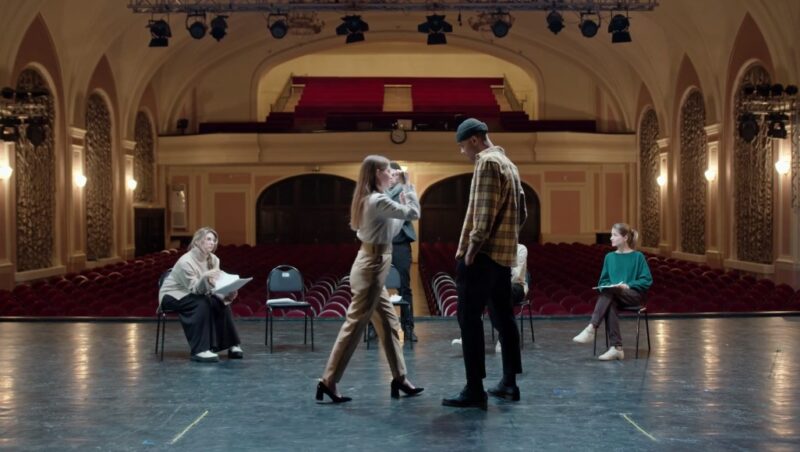For as long as I can remember, I’ve been really into theater and storytelling. One thing that’s always caught my attention is the way stage directions work in plays. They’re like secret guides that tell you how to imagine the story.
In this blog, we’re going to explore what these guidelines really mean and how they help us understand the story better. So, let’s uncover their hidden secrets together!
The Essence of Stage Directions
Stage directions, often italicized or bracketed in the script, serve as the playwright’s voice within the narrative. They provide guidance on:
- movement,
- expression,
- and the physical environment.
These directions are not mere technicalities; they are integral to understanding the plot and the emotional landscape of the characters. By dictating how characters move and interact, these guidelines offer a glimpse into the subtleties of their relationships and internal states.
They Help You Visualize the Scene
For the reader, stage directions act as a lens through which the play’s world comes into focus. They offer descriptive details about the setting, time of day, and atmosphere, helping to paint a vivid picture in the reader’s mind.
This visualization is crucial in understanding the context in which the characters operate. The way a room is described or how the light falls can significantly influence the mood and tone of a scene.
Conveying Subtext and Theme
Stage directions often contain subtext that goes beyond the spoken dialogue. They can hint at a character’s true intentions, foreshadow future events, or subtly reinforce the play’s themes.
This layer of meaning adds depth to the narrative, making stage directions a valuable tool for readers seeking to gain a deeper understanding of the play’s message and nuances.
Their Role in Storytelling

Stage directions in a play are not just ancillary notes; they play a crucial role in storytelling. They bridge the gap between the playwright’s vision and the audience’s imagination, creating a more immersive and complete narrative experience.
The setting of a play, conveyed through these guidelines, establishes the backdrop against which the story unfolds. Descriptions of time, place, and environmental elements like weather or lighting set the mood and tone of the play.
This information is vital for the reader to fully comprehend the world in which the characters exist and interact.
Enhancing Character Development
Stage directions often provide insights into characters that dialogue alone cannot. They reveal hidden emotions, intentions, and traits. For example, a direction indicating a character’s hesitation before speaking or an uneasy glance can reveal inner conflicts or secrets.
These nuances contribute to a richer, more layered understanding of the characters, enhancing the reader’s engagement with the story.
Choreographing Movement and Interaction
The physical movement and interactions of characters are dictated through stage directions. This choreography is not just about where actors stand or move but is imbued with meaning. The proximity of characters to each other, their gestures, and their actions during a conversation all contribute to the subtext of the scene.
These details are critical in conveying the underlying dynamics of relationships and the emotional context of the dialogue.
The Reader’s Perspective

From the reader’s perspective, stage directions are a tool for unlocking a deeper understanding of the play. They provide a framework within which the reader can interpret the narrative, characters, and themes.
Decoding Symbolism and Imagery
Stage directions often employ symbolism and imagery, enriching the narrative with layers of meaning. The use of specific objects, colors, or lighting can symbolize themes or mirror the emotional state of characters.
For a reader, recognizing and interpreting these symbols can greatly enhance the understanding of the play’s deeper messages.
Fostering Emotional Engagement
Through detailed descriptions of characters’ actions and expressions, these guidelines help readers empathize with the characters. They allow readers to visualize not just the physical aspects of a scene but also the emotional undercurrents.
This emotional engagement deepens the reader’s connection to the story, making the experience more impactful.
Aiding in Theatrical Imagination
For readers who may never see the play performed, stage directions are crucial in bringing the script to life in their imagination. They transform the play from a mere script into a vivid, dynamic world that the reader can visualize.
This aspect of stage directions is essential in ensuring that the play remains accessible and engaging, even for those who experience it solely through reading.
Revelation of Character Dynamics

Stage directions are a crucial tool for revealing the dynamics between characters in a play. They often contain subtle cues about relationships, conflicts, and emotions that are not explicitly stated in the dialogue.
These guidelines can provide crucial insights into the relationships between characters. For example, the way characters position themselves relative to each other or the physical contact they make or avoid can speak volumes about their feelings and the nature of their relationship.
These nuances, captured through stage directions, allow readers to perceive underlying tensions, attractions, or conflicts that may not be overtly expressed in words.
Interpreting Non-Verbal Communication
A significant portion of human communication is non-verbal. Stage directions play a critical role in conveying this aspect of interaction. They describe facial expressions, gestures, and body language, offering a window into the characters’ unspoken thoughts and feelings.
For the reader, understanding these non-verbal cues is essential to fully grasp the complexity of character interactions and the subtext of their conversations.
Reflection of the Playwright’s Artistry

Stage directions are not just functional components of a play; they are an expression of the playwright’s artistry and creativity. They reflect the playwright’s style, attention to detail, and narrative vision.
Showcasing the Playwright’s Vision
The specificity and creativity of these guidelines can showcase the playwright’s unique vision for the play. They reveal how the playwright imagines the physical and emotional landscape of the story, offering readers a glimpse into their creative process.
This aspect of stage directions can be particularly enlightening for readers interested in the art of playwriting and the individual style of the playwright.
Balancing Description and Interpretation
The effectiveness of stage directions lies in their ability to balance detailed descriptions with room for interpretation. The good ones guide the actors and directors while leaving space for creative interpretation.
For the reader, this balance allows for an engaging experience where they can visualize the play yet imagine variations based on their interpretation of the text.
Historical and Cultural Context

Stage directions also serve as a historical and cultural record, offering insights into the time and society in which the play was written. They can reflect the social norms, technologies, and environments of the period, making them a valuable resource for understanding the historical context of the play.
These guidelines often include details that reflect the social and cultural norms of the time they were written. This can include the design of spaces, the clothing of characters, or their mannerisms and language.
For readers, these details are not just informative about the play’s setting; they offer a broader understanding of the historical period and cultural backdrop of the story. The evolution of stage directions over time can reveal changes in theatrical styles, societal norms, and technological advancements.
By comparing guidelines from different eras, readers can gain insights into the evolving nature of theatre and the shifting cultural landscapes in which these plays were created and performed.
FAQs
Are there any famous plays known particularly for their unique or innovative use of stage directions?
Several plays are notable for their unique use of stage directions. For instance, Samuel Beckett’s “Waiting for Godot” features minimalist guidelines that leave much to the interpretation of the director and actors.
Tennessee Williams’ “The Glass Menagerie” includes detailed guidelines that blend realistic and symbolic elements, enhancing the play’s dream-like quality.
Do stage directions vary significantly between genres of plays, such as comedy versus tragedy?
Yes, for example, in comedies, these guidelines often include cues for physical humor, exaggerated movements, or comic timing. In contrast, tragedies might have more detailed descriptions of somber settings, slower movements, and intense emotional expressions.
The genre of the play influences the nature and tone of the stage directions, aligning them with the overall mood and style of the work.
Can stage directions be too detailed or overly prescriptive, and how does this affect a play?
This is possible, and it might limit the creativity and interpretation of directors and actors. Excessively specific guidelines can also overwhelm the reader or audience, detracting from the dialogue and flow of the narrative.
Balancing detail with flexibility is key to effective writing.
Is it common for plays to be revised with updated stage directions for contemporary productions?
Yes, it is, especially classic plays tend to be revised with updated stage directions for contemporary productions. This updating process can involve altering the setting, cultural references, or even the portrayal of characters to make the play more relevant and relatable to modern audiences.
How do bilingual or non-English plays handle stage directions, especially in translation?
In bilingual or non-English plays, these guidelines can pose unique challenges in translation. Translators must balance maintaining the playwright’s original intent with adapting the directions to be culturally and contextually appropriate for the target audience.
This often involves careful consideration of cultural nuances, idiomatic expressions, and staging practices to ensure the translation is effective and resonant for a new audience.
The Bottom Line
As we’ve all seen, stage directions are a vital component of a play, as they offer readers a comprehensive understanding of the narrative, characters, and thematic elements.
By providing detailed visual, emotional, and symbolic cues, these guidelines enhance the reader’s experience, making the play a more engaging and enlightening read.

